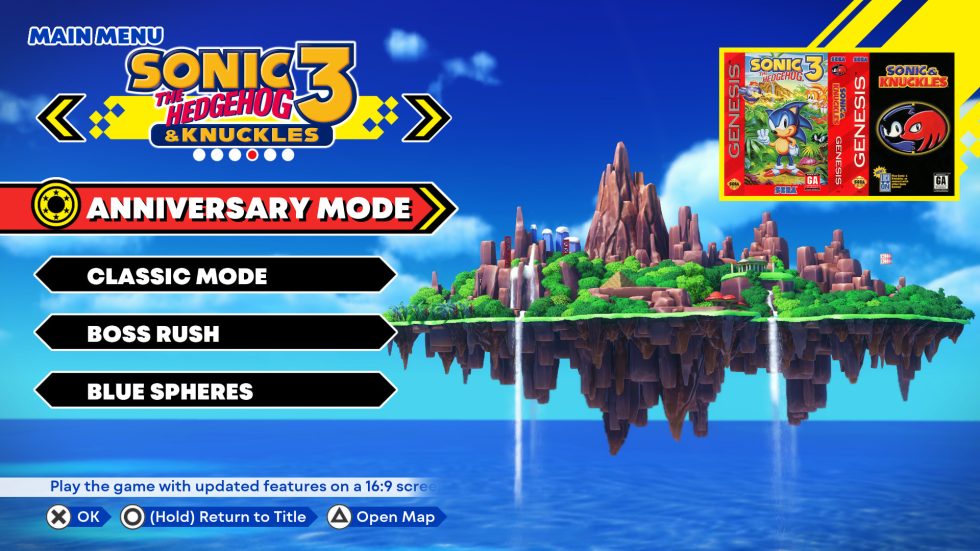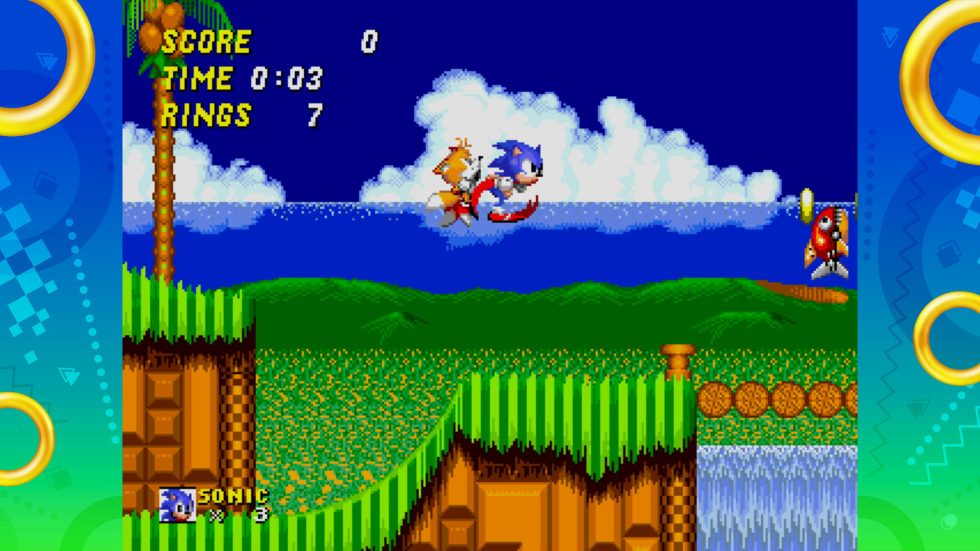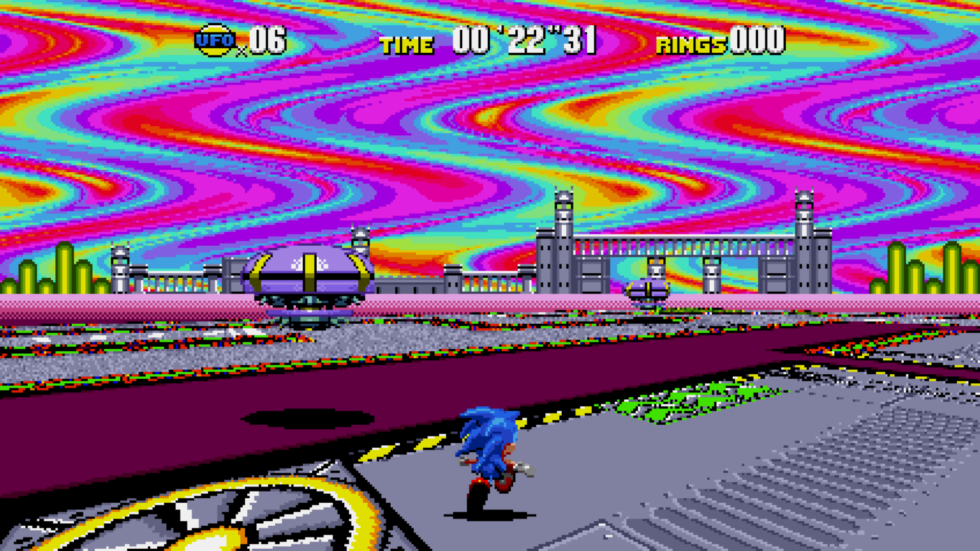
Sega
Here’s a gamer version of “guess how many gum balls are in the jar”: How many times has Sega re-released the very first Sonic the Hedgehog game?
If we don’t ignore six-in-one carts from Sega Genesis and Mega Drive in the ’90s, then the answer is somewhere near 30 launches. That count includes a port of the home version for early ’90s arcades, the Sonic Jam compilation for the Sonic-starved Saturn, versions on various mobile platforms, multiple plug-and-play TV boxes, and a version exclusively playable in Tesla automobiles. Many of these releases came with other 16-bit Sonic games, as well.

Sega
Should you have missed any of the other 30-plus ways to play the series over the years—or have kids who want as much Sonic content as possible after seeing the series’ live-action films—Sonic Origins launches later this week on PC and all console families. Sadly, I’m reviewing this $40 (or, honestly, up to $48) compilation of 16-bit Sonic games not because it’s great, but because it’s weird.
…and Knuckles
Let’s start with the price-to-content ratio, because $40 suggests an amount of Sonic content that would make series fans swoon. I don’t think they will.
The biggest issue is that Sonic Origins only includes four games: Sonic 1, Sonic CD, Sonic 2, and the “complete” version of Sonic 3 (meaning, “and Knuckles” as a locked-on combination of two cartridges). Other compilations have gone above and beyond by adding other Sonic-themed 16-bit games, along with 8-bit games from the Master System and Game Gear, but those are missing this time. Sega doesn’t make up for their absence with stuff like Sonic‘s 3D games from Dreamcast or the series’ edutainment weirdness on the Sega Pico.


Sega
Sonic Origins‘ four included games are emulated quite well, at least. This is largely thanks to Headcannon, a development team that has expertise in touching up Sonic games’ code to preserve the original games’ look and feel while adding modern perks. (Unsurprisingly, they were assisted by Christian Whitehead, a developer who helped Sega officially port Sonic CD to iOS many years ago.) Every game’s “anniversary” mode in Sonic Origins natively supports a 16:9 screen ratio, which makes the series’ high-speed exploration a lot easier to visually track. This mode also includes perks that range from obvious (infinite lives) to subtle (adding the “drop dash” maneuver to older games or supporting a “Knuckles and Tails” mode).
If you’d like to play the games as they were originally designed, you can fall back to a “classic” mode with 4:3 ratios, the original “lives” system, and other Genesis-era stuff intact. (This mode has one caveat, which I’ll get to.)

The Genesis’ unique FM synthesizer sound system is faithfully recreated for the most part, though I’ve so far noticed two odd issues in the pre-release period: Sonic CD will sometimes skip certain sound effects, and certain sound effects suffer from aggressive clipping in Sonic 2‘s bonus stages. All four games’ color calibration looks fantastic for a series that has always favored bright, cheerful palettes. Also, this compilation’s input lag is as low as I’ve measured on a PlayStation 5 game, which is good news, though I’ve yet to test the collection on any other platform.
No rewinds, no visual toggles, no easy-to-peruse museum
But Sonic Origins is missing a few useful features found in other modern 16-bit re-releases. The biggest is the lack of “rewind” or “save state” functions. The game’s default modes save progress between levels, and the optional infinite-lives option is certainly appreciated. Still, the inability to finely rewind or retry specific mid-level moments feels punitive, especially when Sega has made that option available in recent years—particularly in a pair of Switch-exclusive “Sega Ages” ports of Sonic 1 and Sonic 2.
-
If you look at the full-screen version of this image, you may think some of the pixels are being squished. But nope: that’s how the Sonic 2 menu looks on a Sega Genesis, as well.
Sega -
A 500 percent zoom on this screen. This hints at a full 4K rendering pipeline for Sonic Origins on PlayStation 5, as combined with subtle edge-of-pixel effects.
Sega
Each game appears in its original chunky-pixel format—blown up to fill your screen while keeping the Mega Drive’s original aspect ratio. From what I can tell, the upscaling process that Sega uses to fill a 1080p or 4K 16:9 screen with classic pixels doesn’t suffer from left-to-right shimmer or unseemly pixel resizing. But unlike most retro game compilations, Sonic Origins denies its players any visual customization options. Want to blur the pixels together, add a CRT-style filter, or toggle “square” pixels (these look less authentic than the original, intended Genesis visuals, although they reduce HDTV shimmer)? Too bad.
The game’s “museum” collection includes options to listen to tons of original and remixed songs, but Sonic Origins traps them in the museum menu interface. It’s unclear why Sega went to so much trouble to collect a bunch of classic Sonic tunes without letting players toggle “remixed” audio in the original games, let alone create custom in-game music playlists. (Origins actually includes a custom playlist option, but this only plays songs of your choosing in certain menus, not in gameplay.)
And as of press time, I have not figured out how to enable classic “debug” or “level select” content that was in the original games via cheat codes. This is annoying in part because we at Ars Technica have long held that retro collections should allow fans to instantly jump from level to level if they want to. Instead, we’re getting the opposite: no level-select option and no way to use older codes.








